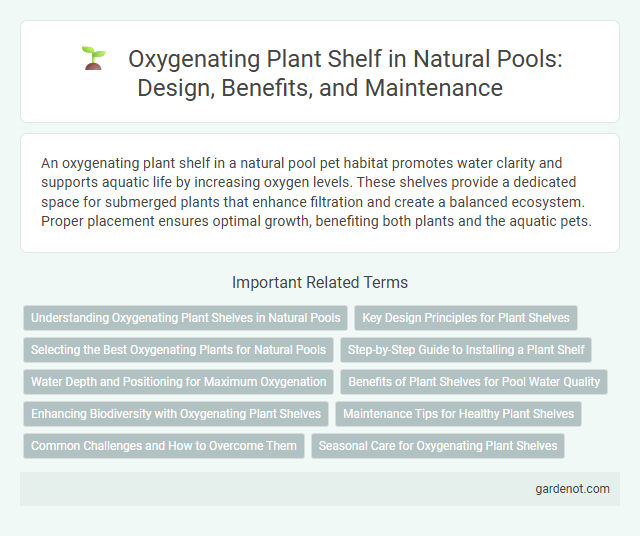An oxygenating plant shelf in a natural pool pet habitat promotes water clarity and supports aquatic life by increasing oxygen levels. These shelves provide a dedicated space for submerged plants that enhance filtration and create a balanced ecosystem. Proper placement ensures optimal growth, benefiting both plants and the aquatic pets.
Understanding Oxygenating Plant Shelves in Natural Pools
Oxygenating plant shelves in natural pools serve as vital zones where submerged aquatic plants release oxygen directly into the water, enhancing overall pool health and clarity. These shelves support species such as hornwort and anacharis which efficiently increase dissolved oxygen levels, promoting beneficial microbial activity and inhibiting algae growth. Proper design includes shallow areas with filtered sunlight to maximize plant photosynthesis, ensuring a balanced ecosystem and sustainable water purification.
Key Design Principles for Plant Shelves
Oxygenating plant shelves in natural pools enhance water quality by providing habitat for aquatic plants that regulate oxygen levels, crucial for maintaining ecosystem balance. Key design principles include ensuring adequate water depth of 40-80 cm to support diverse plant species, optimizing shelf width for sunlight exposure, and positioning shelves to maximize water flow, facilitating nutrient exchange and minimizing stagnation. Materials used should be durable and non-toxic, promoting long-term stability and healthy plant growth within the natural filtration system.
Selecting the Best Oxygenating Plants for Natural Pools
Choosing the best oxygenating plants for a natural pool enhances water clarity and supports aquatic life by increasing dissolved oxygen levels. Species like Hornwort (Ceratophyllum demersum), Anacharis (Egeria densa), and Water Milfoil (Myriophyllum spicatum) are effective for rapid oxygen production and nutrient absorption. Proper placement of these plants on submerged shelves ensures optimal growth and maintains a balanced ecosystem within the natural pool.
Step-by-Step Guide to Installing a Plant Shelf
Installing an oxygenating plant shelf in a natural pool involves selecting a sturdy, water-resistant frame positioned 12 to 18 inches below the water surface to support submerged aquatic plants that enhance oxygen levels. Securely anchor the shelf using weighted materials or structural supports to prevent movement and ensure stability despite water currents. Populate the shelf with native oxygenating plants such as hornwort, anacharis, or watermilfoil for optimal water quality improvement and ecosystem balance.
Water Depth and Positioning for Maximum Oxygenation
Oxygenating plant shelves in natural pools should maintain a water depth of 20 to 40 centimeters to optimize oxygen release and nutrient absorption. Position these shelves in well-lit, shallow areas where sunlight penetrates effectively, enhancing photosynthesis and boosting dissolved oxygen levels. Correct placement and depth promote healthy aquatic ecosystems and improve water clarity through natural filtration.
Benefits of Plant Shelves for Pool Water Quality
Oxygenating plant shelves enhance natural pool water quality by promoting higher oxygen levels, which supports beneficial aerobic bacteria that break down organic matter and reduce harmful algae growth. These shelves serve as natural biofilters, improving water clarity and maintaining balanced nutrient levels essential for a healthy aquatic ecosystem. Incorporating diverse aquatic plants on shelves also stabilizes the pool environment, contributing to sustainable, chemical-free water purification.
Enhancing Biodiversity with Oxygenating Plant Shelves
Oxygenating plant shelves create optimal habitats that support diverse aquatic life by improving water oxygen levels and providing shelter for microorganisms and small fish. These shelves increase the natural filtration capacity of a natural pool, reducing the need for chemical treatments and promoting a balanced ecosystem. The integration of oxygenating plants like Myriophyllum and Elodea fosters enhanced biodiversity by sustaining various species, contributing to the health and resilience of the aquatic environment.
Maintenance Tips for Healthy Plant Shelves
Maintaining an oxygenating plant shelf in a natural pool requires regular removal of dead leaves and debris to prevent water contamination and ensure optimal oxygen release. Monitoring water quality parameters, such as pH and nutrient levels, supports healthy plant growth and prevents algae overgrowth. Seasonal pruning and occasional replanting enhance the vitality of aquatic plants, sustaining the ecosystem's natural filtration and oxygenation functions.
Common Challenges and How to Overcome Them
Oxygenating plant shelves in natural pools often face challenges such as poor water circulation, algae buildup, and insufficient oxygen levels. To overcome these issues, carefully designing shelf depth and positioning promotes optimal water flow, while regular removal of decaying plant matter prevents nutrient overload that fuels algae growth. Selecting resilient oxygenating plants like eelgrass or hornwort enhances oxygen production, ensuring a balanced aquatic environment.
Seasonal Care for Oxygenating Plant Shelves
Seasonal care for oxygenating plant shelves in natural pools involves monitoring water temperature and nutrient levels to ensure optimal plant health from spring through fall. Regularly removing debris and trimming dead foliage enhances oxygen production and prevents decay that can affect water quality. Winter preparation includes lowering water levels and protecting sensitive plants from freezing to maintain a balanced aquatic ecosystem year-round.
Oxygenating plant shelf Infographic

 gardenot.com
gardenot.com